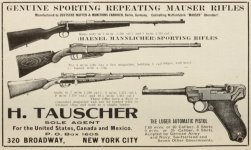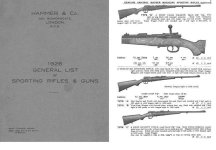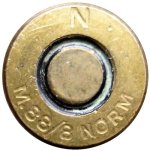ajczarkowski
Member
Hello again everyone! I admit I wasn't sure if this would be the right sub-section of the forum to post this topic/question in, so if it needs to be moved I 100% understand.
Anyways, I am trying to piece a bunch of pieces of a puzzle together. I don't think there's a better forum than this one to get some info on this topic. I actually don't know if there are any solid answers to any of the questions I may ask in this thread, lol... so It's really more of a discussion because I'd like to see what other forum members may have info on.
I went down a rabbit hole over the past few months. I have been researching Mauser and Commission Rifle sporters that were sold commercially. Specifically in 8mm chamberings... I noticed that in catalogs (including US catalogs), these rifles were marketed as using .315 caliber bullets (I have attached a couple of examples below).
On the Sportsman's Vintage Press website, they have a really interesting page written on the Mauser sporting rifles. Interestingly enough, there is not a 8x57, 7.92, or 8mm Mauser etc., listed as a chambering for any of these rifles. Just 8x51mm w/ .315 caliber bullets and 8x60mm w/ .315 caliber bullets.
Link: https://sportsmansvintagepress.com/read-free/mauser-rifles-pistols-table-of-contents/mauser-sporter/
I admit I originally became interested in this topic because I bought an 1888 Commission Rifle/Gewehr 88 (big shoutout to those forum members who helped me get it shooting again, I've since bought another one!). And I read that the rifles with older barrels (pre "Z" marking on top of the receiver) had a .318" bore diameter. Two things to note about this - 1). I believe those who gave me this information meant groove and not bore and 2). I believe they were confusing the original groove diameter of the military style Commission Rifle with that of the sporting/commercial rifles of the era.
My understanding now is that up until mid 1896, the 1888 Commission Rifle/Gewehr 88 barrels were something along the lines of .320/.321" groove diameter and after mid 1896 they had the Z barrels, which were .323+ grooves and that would continue with Mauser Gewehr 98 production.
Why were commercial production Mauser 98 and 1888 Commission Rifle sporters being marketed with .315" bullets? I suspect those might be the source for the .318" groove barrels? I know the Czechs rebarreled some of their captured Gewehr 88s to this size barrel... why would the Czechs rebarrel a military rifle to this sporting size?
It might also be worth noting I can't seem to find the name of this .315" round... Some may say "8x57j", but isn't that just the round nose original 8x57 M88 round? I have found pictures of headstamps marked, "M88/8", could this be what I'm looking for? I have noticed on most of these sporting rifles, they are marked 7.8mm instead of 7.9mm or 7.92...
Why would the Germans use tighter dimensions in their sporting rifles than in their military rifles? And why did the Czechs opt to rebarrel their Gewehr 88s with the sporting dimensions? I'm sure some might point to the treaty of Versialles, but aren't there examples of rifles with these tighter dimensions predating WWI? I'd also love to find more information on this .315 caliber that I can't find the name of...
I wish I had the funds to buy tons of these rifles and different ammo types and measure them all, lol.
Anyways, I am trying to piece a bunch of pieces of a puzzle together. I don't think there's a better forum than this one to get some info on this topic. I actually don't know if there are any solid answers to any of the questions I may ask in this thread, lol... so It's really more of a discussion because I'd like to see what other forum members may have info on.
I went down a rabbit hole over the past few months. I have been researching Mauser and Commission Rifle sporters that were sold commercially. Specifically in 8mm chamberings... I noticed that in catalogs (including US catalogs), these rifles were marketed as using .315 caliber bullets (I have attached a couple of examples below).
On the Sportsman's Vintage Press website, they have a really interesting page written on the Mauser sporting rifles. Interestingly enough, there is not a 8x57, 7.92, or 8mm Mauser etc., listed as a chambering for any of these rifles. Just 8x51mm w/ .315 caliber bullets and 8x60mm w/ .315 caliber bullets.
Link: https://sportsmansvintagepress.com/read-free/mauser-rifles-pistols-table-of-contents/mauser-sporter/
I admit I originally became interested in this topic because I bought an 1888 Commission Rifle/Gewehr 88 (big shoutout to those forum members who helped me get it shooting again, I've since bought another one!). And I read that the rifles with older barrels (pre "Z" marking on top of the receiver) had a .318" bore diameter. Two things to note about this - 1). I believe those who gave me this information meant groove and not bore and 2). I believe they were confusing the original groove diameter of the military style Commission Rifle with that of the sporting/commercial rifles of the era.
My understanding now is that up until mid 1896, the 1888 Commission Rifle/Gewehr 88 barrels were something along the lines of .320/.321" groove diameter and after mid 1896 they had the Z barrels, which were .323+ grooves and that would continue with Mauser Gewehr 98 production.
Why were commercial production Mauser 98 and 1888 Commission Rifle sporters being marketed with .315" bullets? I suspect those might be the source for the .318" groove barrels? I know the Czechs rebarreled some of their captured Gewehr 88s to this size barrel... why would the Czechs rebarrel a military rifle to this sporting size?
It might also be worth noting I can't seem to find the name of this .315" round... Some may say "8x57j", but isn't that just the round nose original 8x57 M88 round? I have found pictures of headstamps marked, "M88/8", could this be what I'm looking for? I have noticed on most of these sporting rifles, they are marked 7.8mm instead of 7.9mm or 7.92...
Why would the Germans use tighter dimensions in their sporting rifles than in their military rifles? And why did the Czechs opt to rebarrel their Gewehr 88s with the sporting dimensions? I'm sure some might point to the treaty of Versialles, but aren't there examples of rifles with these tighter dimensions predating WWI? I'd also love to find more information on this .315 caliber that I can't find the name of...
I wish I had the funds to buy tons of these rifles and different ammo types and measure them all, lol.
Attachments
Last edited:






